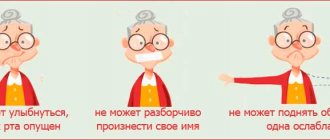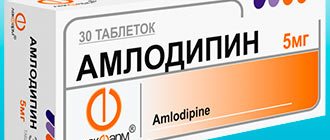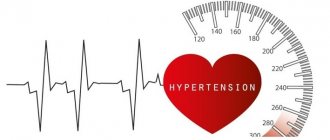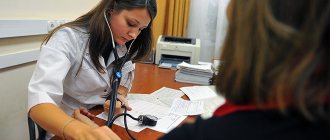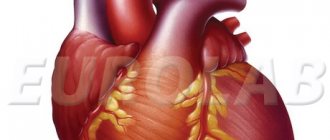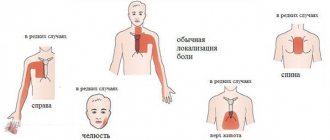Publication date: March 27, 2019
Stroke is a rapidly developing dysfunction of the central nervous system, which can be caused by hemorrhage (hemorrhagic form) or spasm or blockage of cerebral vessels (ischemic type). Recovery from a stroke on the right side is a fairly long process. Patients are strongly recommended to undergo rehabilitation in specialized centers under the supervision of qualified doctors.
Etiopathogenesis
If the patient is paralyzed, then a stroke (hemorrhage) has occurred. Violation of the integrity of the arterial wall leads to the formation of a hematoma. As blood accumulates outside the vessel, it begins to put pressure on neighboring brain structures. Under these conditions, nerve cells responsible for key brain functions, such as muscle control, die, causing entire parts of the body to go numb.
A stroke with paralysis of the right side can be caused by the following factors:
- Wrong diet. It is very important to monitor the amount of calcium in the foods you eat, as it is a key element in maintaining the health of arterial walls. A lack of calcium leads to weakening of blood vessels and increases the risk of their damage. In this case, even small blood congestions can provoke hemorrhage.
- High blood pressure. Excessive blood pressure on the walls of the arteries can lead to their damage in the weakest places. As a rule, people at high risk are older people who experience deterioration in the elasticity of the vascular walls due to natural aging and low calcium levels.
- Hereditary predisposition. Recently, it was found that patients with a family history of stroke are likely to have a heart attack or stroke at some point in their lives. These are mainly patients with hypertension. While the specific inherited cause of the disease has not yet been established, it may be weak blood vessels and problems with neurohumoral regulation.
- Excess weight. Fat people tend to have low levels of minerals in the blood and high blood pressure - leading causes of stroke, which can paralyze the body.
- Diseases of the cardiovascular system. Impaired blood flow and rupture of a vessel in the brain can provoke pathologies such as heart defects, heart failure, the formation of atherosclerotic plaques and blood clots.
- Endocrine diseases. The most common cause of stroke among this group of pathologies is diabetes. People with this condition often suffer from high blood pressure. Also at risk are patients with low levels of thyroid hormones and problems in the adrenal cortex.
- Alcohol and tobacco abuse. Nicotine reduces the strength of arterial walls and increases cholesterol levels in the blood. High-quality alcoholic drinks in small quantities can even be beneficial, but frequent and excessive consumption of alcohol easily provokes hemorrhage with subsequent paralysis.
The causes of paralysis of both the right and left parts of the body are indicated above. Statistics show that bad habits are the most common factor in paralysis, in which it is much more likely to help the patient survive if diagnosed in time.
Signs
A vascular accident does not occur asymptomatically; it is preceded by cerebrovascular accidents. A stroke often occurs while sleeping or upon awakening. Drinking alcohol and taking a hot bath can also trigger cerebral vasospasm. The development of ischemic stroke of the right hemisphere as a result of thromboembolism is characterized by pronounced symptoms.
In patients admitted to the neurology clinic of the Yusupov Hospital, the following symptoms of the disease are revealed during diagnosis:
- partial or complete paralysis of the left side of the body;
- disturbances in sensation and perception of one’s own body and objects;
- loss of memory about current events, while patients remember past events;
- ignoring the left visual field;
- left-handers experience speech disorders;
- inability to concentrate;
- disorders of the emotional-volitional sphere of personality;
- depressive states;
- unbalanced behavior;
- changes in the face, in which the corner of the mouth droops, the nasolabial fold on the right side is smoothed out.
Ischemic stroke of the right hemisphere is characterized by the predominance of general cerebral signs of disturbance over focal ones at the beginning of the attack. Treatment of ischemic stroke at the Yusupov Hospital is carried out using innovative techniques that significantly increase the likelihood of restoration of lost functions and the chances of recovery.
Types of paralysis
When a person is admitted to hospital with a stroke, it is important to determine from the outset whether they have paralysis and what its nature is. Paralysis in all parts of the body (left and right sides) is divided into 2 groups.
- Peripheral paralysis. This is a milder form of the disorder, accompanied by selective loss of body function. In this case, motor nerve cells are damaged, numbness occurs, and the person cannot perform complex actions.
- Central paralysis. This condition is associated with the formation of a hematoma in the areas of the brain responsible for movement. This causes complete paralysis of the right leg or arm. Such patients lose the ability to self-care and may remain disabled for life.
How to recognize paralysis on the right side?
When a stroke occurs in the left hemisphere of the brain, the right side is usually affected, the muscles of the legs and arms are paralyzed, and speech is lost. Such symptoms allow us to say with confidence that the patient has right-sided paralysis. In addition, additional symptoms are noted.
- The main signs of a stroke are sudden fatigue, severe headache, nausea and vomiting. These symptoms are observed in the patient on the first and second days after the attack and are characteristic behavior of the body when brain cells die.
- Immobilization. If the central part of the brain is damaged, the right leg and arm cease to obey, become numb and sag. If the peripheral nerve cells are damaged, the right side of the body begins to tremble, and the patient cannot perform certain actions, but overall mobility is maintained.
- Memory impairment. It is difficult for the patient to repeat several phrases at once. With a serious disorder, the patient instantly forgets even one word.
- Disruption of the right facial nerve - this leads to loss of control over the muscles of the entire right side of the face, and the ability to make facial expressions is lost. As a result, the right side of the mouth and eyelid droop down.
- The skeletal muscles of the right side of the body contract in any direction. As a rule, the arm bends at the elbow, the leg straightens, and the foot turns toward the center.
The above symptoms appear within minutes after a stroke. Due to disruption of the functioning of different parts of the body, the patient experiences a stressful state, which can lead to nervous breakdown and rejection of social contacts.
Fighting bedsores
Bedsores are a dangerous enemy of bedridden patients who have to remain in bed for long periods of time. Bedsores appear in areas that are subject to the greatest pressure - the tailbone, shoulder blades, buttocks, legs, forearms.
Bedsores in advanced stages require surgical treatment. There are cases when a patient was saved in intensive care, but then, due to poor care, he died from sepsis that developed from banal bedsores. Nursing after a stroke is exactly the case when an experienced and conscientious nurse is just as important as a doctor. And sometimes it’s even more important.
What does paralysis of the right side entail?
If the left hemisphere is seriously damaged, the patient may be paralyzed for the rest of his life. Permanent disability is the result of a large hematoma in the brain or improper treatment. Let's look at a few common complications:
- paralysis of all limbs;
- irreversible speech impairment;
- deterioration of cognitive functions, including thinking abilities, memory, interaction with society;
- formation of bedsores;
- worsening of existing chronic diseases due to loss of mobility;
- problems with holding urine and feces.
To recover from a stroke on the right side, treatment is selected that will help reduce the risk of such conditions.
Lifestyle
Stroke is a disease in which a person must start life in new conditions. Most people find it difficult to accept their condition, so deep depression is as dangerous a complication as the physical manifestations. Already in the first stages of recovery, much attention is paid to this aspect.
The scientific, material and technical base of the Yusupov Hospital allows patients to undergo rehabilitation procedures using modern equipment that meets European standards.
Treatment
Therapy after a stroke helps restore normal blood flow to the damaged area of the brain and reduce the risk of developing vascular problems and having another stroke. The patient may be prescribed a complex of medications and folk remedies.
Drug therapy
If the right side of the body is paralyzed after a stroke, the doctor first prescribes medications.
- Anticoagulants and antiplatelet agents (for example, Warfarin and Curantil) - prevent the formation of blood clots, making it more fluid, which improves blood flow even through the narrowest sections of blood vessels. These drugs help improve the condition of patients with atherosclerosis, blood clots, or narrowed blood vessels.
- Agnioprotectors (“Alprostan”, “Parmidin”) - normalize the functioning of the walls of blood vessels, reducing the risk of reducing the lumen in the arteries.
- Antispasmodic drugs (such as Vincamine and Papaverine) help relax the vascular walls, which increases blood flow.
- Diuretics (“Veroshpiron”, “Hypothiazide”) - help remove excess fluid from the body, reducing the risk of developing cerebral edema and exacerbation of hypertension.
- Nootropics (“Actovegin”, “Piracetam”) - increase brain performance. Nootropics are prescribed throughout recovery and for some time after full recovery.
Drug therapy is selected individually, based on the diagnosis and the general health of the patient. In case of serious disorders, the patient is given all types of medications and his blood pressure is monitored.
Folk remedies
Traditional medicine provides additional assistance in recovery and is prescribed along with basic medications. In case of serious health problems, consultation with a specialist is necessary to draw up a specific treatment and preventive program.
Let's consider the most effective folk remedies.
- Taking a bath with the medicinal plant oregano. First you need to boil water along with the herb in the proportion of a liter per spoon and then pour it into the bath. For an average bath, 5 or 6 liters of decoction is enough.
- Honey and propolis are thoroughly mixed in a vessel with a ratio of 100 to 1, after which they are left to infuse for three days. The finished product is taken a couple of drops twice a day.
Folk remedies help improve blood flow and supply brain tissue with essential nutrients, as well as improve the functioning of the immune system.
Causes of development of cerebrovascular accidents
The cause of the development of right-sided ischemic stroke is the cessation of blood supply to the hemisphere. This condition occurs due to blocking of the lumen of the vessel by an atherosclerotic plaque, embolus or thrombus. The area of damage directly depends on the size of the lumen of the blood vessel.
Ischemic stroke of the right hemisphere is a studied disease. The main reasons for its development are:
- the age of the patient, the risk of developing the disease is higher in older people;
- gender - up to 80 years of age, the likelihood of ischemic stroke is higher in men, but after this age the opposite trend is observed;
- chronic stress, increased anxiety;
- burdened heredity, this reason is confirmed by numerous studies devoted to the issues of vascular accidents in people whose family members have suffered a stroke.
Doctors identify causes that can be corrected in order to prevent ischemic stroke:
- high blood pressure;
- irrational lifestyle and use of toxic substances, overeating;
- increased body weight;
- taking combined oral contraceptives;
- atherosclerotic vascular lesions.
Primary prevention of ischemic stroke is aimed at correcting lifestyle, increasing human activity, and reducing body weight.
Rehabilitation
The main goal of rehabilitation after a stroke is the return of movements in the right side of the body, speech and other cognitive abilities. First of all, the patient is recommended to follow a certain diet, go to massage, physiotherapy and consult a speech therapist.
Diet
In order for blood flow and other body systems to recover faster, you need to limit yourself to certain foods and focus on healthier foods. The body must receive all the necessary substances with food to restore damaged tissues.
dieta-after-insulta
When preparing a diet, you should adhere to a number of conditions:
- do not eat smoked meats or foods high in fat;
- meat products should be consumed lean, in small quantities (preferably in crushed form) and only after consultation with a doctor;
- eat more fresh fruits and vegetables;
- do not drink drinks high in caffeine, sugar or alcohol;
- eat food often, but in small quantities.
In case of serious consequences of a stroke, the products should be selected by a nutritionist, taking into account the patient’s health and level of energy consumption.
Massage
Massage is necessary to prevent the formation of bedsores, so it is prescribed from the very beginning on a daily basis. During the procedure, the entire right side of the body is warmed up. This helps normalize blood flow, molecular processes in cells and joint functions.
Therapeutic massage of the paralyzed part includes:
- stroking the body from the limbs towards the blood flow;
- rubbing the skin is carried out in the same direction, but more actively;
- creating vibration in the softest places;
- repeated stroking at the end of the session.
You can avoid the development of bedsores if you carry out similar actions every day. It is also important to frequently shift the patient, changing his position, and rub with alcohol (if there are no skin disorders).
Physiotherapy
Physical therapy is prescribed after 2 or 3 weeks from the moment of the stroke, if the patient is clearly on the mend. Physical education is prescribed to achieve a number of goals:
- reducing the risk of muscle atrophy;
- increasing the ability of nerve tissue to transmit impulses to muscles;
- regaining the ability to control the body and take care of oneself independently.
lechebnaya-fizkultura
The most effective physical therapy is prepared by a specialist who can select exercises to restore certain abilities.
How to prolong and improve life after an ischemic stroke
The period after an ischemic attack is divided into five periods:
- The critical stage is the first 72 hours.
- Acute period – 25-30 days.
- The first stage of recovery is from 3 to 6 months.
- The second recovery period is 12–24 months.
- Residual processes – From 24 months or more.
Life expectancy after an ischemic stroke depends on numerous factors, from the size of the brain lesion to treatment measures. Providing first aid also affects the outcome of recovery; a simple rule applies here: the sooner, the better.
In the first year after ischemic hemorrhage, 65% of patients survive, after 5 years half survive, but after 10 years only a quarter remain alive.
Help to prolong life:
- correct lifestyle;
- diagnostics every 2 – 3 months;
- nutrition;
- restorative gymnastics.
Salt, sugar, fatty and flour foods, smoked meats and sauces should be excluded from the diet. The diet should be dominated by vegetables and fruits, a large amount of fiber and vegetarian soups. Meals should be fractional, 5 meals in small portions.
Timely diagnosis and physical therapy, which improves the quality of blood flow, will help prevent a recurrent attack.


